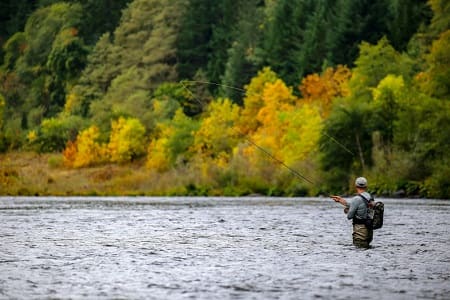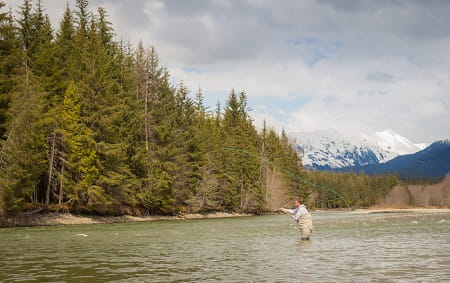Best Spey Fishing Sink Tips and Switch Line Sink Tips

Sink tips for Spey fishing, or what some call Spey sink tips are used when spey fishing for trout, steelhead, and salmon with flies that need to get down to the fish. In many cases, if I or my clients don’t get the fly close enough and deep enough, the fish just won’t grab it.
There are also ways to increase or decrease the sink rate of my sink tip and the fly. The leader or tippet length between my sink tip and the fly can greatly affect my casts and how deep my fly gets.
Steelhead Spey fishing is growing, and with that comes newer and better sink tips, so be sure to check back now and then to ensure you know about the latest and greatest sink-tips.
How Deep Do Spey Sink Tips Need To Get

Normally, I only need to get my fly three feet or less over the fish’s head. Some conditions like dirty water will change that. In my experience, I have found the closer I get my fly to the fish the better.
Let’s explore effective techniques for achieving the desired fly depth. The objective is not simply to reach the maximum depth but rather to target the specific zone where I believe the fish are holding.
In warmer conditions with good water clarity, depth is less critical since fish can be more active and willing to chase a fly that is further away. This is when even a fly that is four to six feet over the fish’s head can work.
However, when the conditions turn cold or the water becomes murky, it’s crucial to get the fly precisely in the desired zone and be as close as possible.
Methods I Use To Get My Spey Sink Tips Down

The following methods, either individually or in combination, can help me achieve the desired depth. I use the method that best suits the conditions I am faced with.
I tell my clients to get familiar with at least a couple of these methods so they can adapt as needed.
- Submerge with Extended Sink Tips: Using a longer sink tip enables my fly to sink deeper and maintain its depth throughout the swing. A sink tip measuring 12.5 to 15 feet qualifies as a longer option.
- Enhance Sinking Time: Casting at an angle of 90 degrees or greater across the river allows my fly and sink tip more time to descend, I do this a lot when fishing and guiding. Similarly, casting first and then taking subsequent steps downriver provides additional sinking time on the fly since the time to drag is extended. Another approach involves casting at the desired angle and mending the line to maximize the sinking duration. I discuss this in my article, Spey Fishing For Steelhead.
- Getting Shallower With the Same Tip: Casting further downriver so my line, the sink tip, and fly start to pull immediately will prevent them from getting as deep as the above 90-degree angle. If I start bumping bottom I’ll simply change the angle first, and then lighten the sink tip if that angle change does not work.
- Adjust Leader Length and Fly Weight: To swiftly reach the desired depth, employ a long leader (4-7 feet) combined with a heavy fly. However, note that casting may become more challenging as the mass of the fly moves farther away from the sink tip and head. Conversely, when using a lightweight fly that needs to sink, opt for a shorter leader (2.5-3.5 feet) to prevent the fly from floating above the tip by staying connected to the sink tip.
- Utilize Sinking Heads: While traditional Skagit heads, like Rio Skagit Max, are designed to float, other options like, Airflo FIST heads and Rio Game Changer heads integrate a sinking section within the shooting head, facilitating deeper fly penetration.
Understanding Skagit Sink Tips Weights
Sink tips come in various weights that correspond to the weight of the head used. Tungsten sink tips are measured in grains per foot.
For example, T-14 (Tungsten 14) signifies 14 grains per foot, resulting in a total weight of 140 grains for a 10-foot tip. By adjusting the length, it is possible to estimate the impact on the overall weight of the tip.
Additionally, sink tips can be constructed using different materials to achieve a specific density. For instance, Rio’s 15-foot Replacement Tips come in Intermediate, which sinks at a rate of 1-2 inches per second.
Recommended Sink Tips:
- OPST COMMANDO SINK TIPS: These specialized sink tips enable me to effectively explore deeper sections of the water column, whether using the swinging technique or stripping a streamer. They are particularly useful for executing spey-style presentations even when using single-hand rods.
- Rio IMow Tips: Rio IMOW 5&5 Tip: This versatile tip combines a 5-foot floating section with a 5-foot sinking section. It offers a good balance between ease of casting and sinking capability, allowing me to adjust the depth as needed.
- Rio InTouch 15′ Spey Sink Tip
- Designed for Spey casting, this 15-foot sink tip offers excellent sinking capabilities.
- Rio 15ft Type 3 Replacement Tip
- The Type 3 tip sinks at a rate of 3-4 inches per second, making it ideal for fishing with lightweight flies in soft and slightly turbulent water. I recommend using the 9 or 10wt tips for line weights of 500 grains or higher.
- Rio Intouch Long Mow Tip
- The Rio MOW Long Tip provides a length of 15 feet with a T-14 rating, making it suitable for dredging through deep holes or fishing fast sections of the run with rocky structures. It offers excellent control and depth penetration.
- Rio 15ft INT Replacement Tip
- This intermediate tip sinks at a rate of 1-2 inches per second, making it ideal for fishing muddlers in the summer or slow pools. Similar to the previous tips, I recommend using the 9 or 10wt versions for line weights of 500 grains or higher.
By having these sink tips with me, I will have what I need to match specific fishing conditions and target different water depths effectively.
Remember, the key to successful fly fishing lies in understanding the conditions, adapting the approach, and selecting the appropriate sink tips to achieve the desired fly depth. Experimentation and experience will guide you toward finding the optimal combination for each fishing scenario.
Every angler may have their own unique fishing style and requirements. Therefore, I encourage you to experiment and adjust your sink tip selection accordingly.
When expanding your sink tip collection, it’s important to consider factors such as water depth, current speed, target species, and water conditions. These elements can greatly influence the effectiveness of different sink tips.
Spey Sink Tips Conclusion
Remember, the ultimate goal is to achieve the desired depth and presentation that entices fish to strike. By mastering the art of selecting and utilizing the appropriate sink tips, you enhance your chances of success on the water.
Tight lines,
Graham
